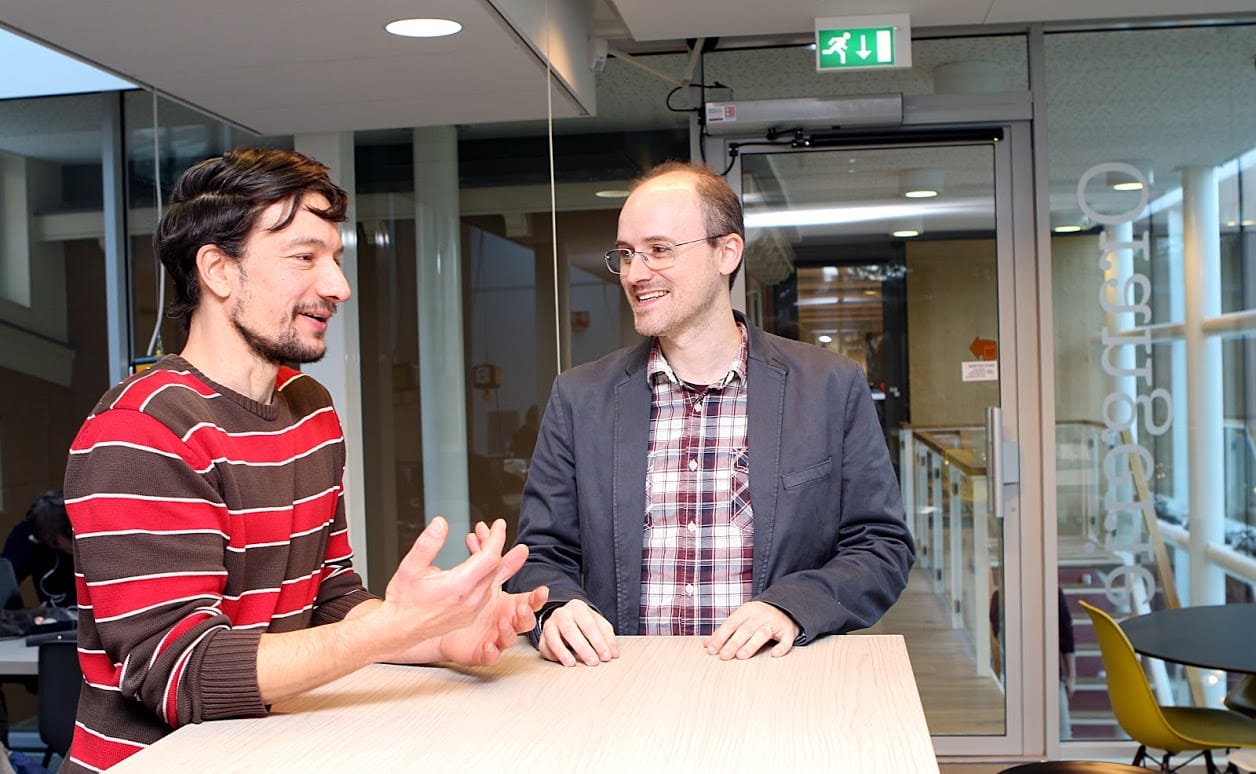
Duo-Interview: Perspectives on Social Coordination
In the past ten years there has been a rapid growth in research focusing on human coordination in social situations (e.g., at the workplace, on the sports field, in the classroom, between mother and child, etc.). People seem to have a tendency to coordinate with others in their actions, feelings, and cognitions. Psychological studies have shown that behavioral coordination relates to psychological constructs such as social unity, liking, and cohesion, which in turn may also influence the degree of behavioral coordination.
Mindwise asked two experts to explain us more about this intriguing topic. Dr. Pontus Leander from the department of Organizational Psychology and Dr. Ralf Cox from the Department of Developmental Psychology study social coordination from very different perspectives.
“Coordination occurs naturally and spontaneously, like synchronized clapping and mimicry, or functionally and intentionally, like joint action.”
What is social coordination, according to Dr. Pontus Leander and Dr. Ralf Cox?
Dr. Leander: Social coordination can happen in many ways, but my view is that it occurs when two or more people behave in a way that forms a social unit. It could simply be two people mimicking each other – such as walking in-step, but it could also be two people engaging in very different behaviors but towards a common goal – such as one person helping another climb a wall. Yet it could also be about good timing, such as having a conversation wherein both parties respond to each other at a reliable pace. Social coordination seems to involve a kind of behavioral accommodation to another person.
Dr. Cox: Coordination is generally understood to be the (self-)organizational process by which components within a system, such as birds in a flock, the segments of your body, or people in a group, ‘connect’ to form larger functional units that allow for more complex behaviors, like swarming, walking or conversing, respectively. Social coordination refers to the pattern formation in interpersonal behavior of individuals within dyads and groups. In social coordination the individuals’ behavior is modified through the interactions with others. This occurs naturally and spontaneously, like synchronized clapping and mimicry, or functionally and intentionally, like joint action. The question for psychologists is how this comes about.
Can you explain what methods you use to study social coordination from your research perspective, and why you use these methods?
Dr. Leander: I examine how and when we adopt the behaviors and psychological states of the people around us. Mimicry and various social contagion effects are forms of social coordination that involve unconsciously adopting features of people we come into contact with. In our behavioral mimicry studies, research volunteers interact with another person who is subtly mimicking them, and we try to see if the mimicry has a unique persuasive influence. In our social contagion studies, we try to see if mere exposure to the goals and motivations of other people leads research volunteers to adopt similar goals themselves, as manifested in their own behavior later on.
Dr. Cox: A key issue is the “self-organizational” process underlying social coordination. This is studied in social coordination dynamics, by asking questions like: What types of behavioral patterns are formed, and how? And how do changes in these patterns come about? Also, how do social connectedness, momentum, etcetera emerge from social coordination dynamics? In the Developmental Psychology lab we use Wii controllers, Wii balance boards and rowing ergometers to investigate social coordination dynamics in children and adults. Our focus is on the temporal organization of interpersonal behavior in dyadic tasks such as simple games and matches, involving either cooperation or competition.
“Social coordination does not necessarily occur at a single point in space and time. Actions can be months, or even years apart.”
Dr. Cox asks Dr. Leander: “You mention “timing”. To what extent do you think this is important? I ask this because in my line of work this is considered to be a key aspect of interpersonal coordination, and understanding the nature and origin of coordination dynamics is one of the research goals.”
Dr. Leander: I agree timing is key for social coordination but for all kinds of different reasons. In a conversational setting, a steady back-and-forth may require a good tempo to feel coordinated. Yet social coordination need not require people to interact at a single point in space and time. For example, in the Shawshank Redemption, prison escapee Andy Dufresne leaves a hidden cache under some rocks for his friend Red to find whenever he got out on parole—be it months or even years later. This is still a form of social coordination because Andy and Red shared the common goal to meet outside prison, and since Andy got out of prison first he had to be the one to make arrangements for Red to find him. So I agree timing is key – but what “timing” means depends on the situation.
Dr. Leander asks dr Cox: “In your line of work, do you see social coordination as predominantly intentional (i.e., motivated) or is it just an incidental byproduct of perception and automatic responses? I get why social coordination may have evolutionary advantages, but in my mimicry research I cannot escape the sense that it is probably motivated by something… I just can’t figure out what that “something” is.”
Dr. Cox: I think it is neither fully intentional nor a byproduct. First of all, humans and other social organisms are evolutionarily equipped with perception-action systems for coordinating with others, and, more generally, for attuning to the social and material niche they inhabit. Secondly, many of the social constructs we psychologists are concerned with, including motivation and intention, are shaped by coordination dynamics and are secondary to it. Interpersonal coordination is primarily perception-action based, that is to say, it is (radically) embodied, self-organized and dynamic. But it is also situated in an environment, a context, and, occasionally, is goal directed. These (potentially many) constraints codetermine the patterns of coordination that emerge, whether it’s simply mimicry or a more sophisticated type. Motivation and intention might in some sense guide a person’s choice of goal or partner, or selection of environment. And although these (partly voluntary) factors might set the stage for social coordination, perception-action processes self-regulate its size and shape.
“People seem to tie together many processes, from heart rate to eye movements to future plans, not only the behavioral level.”
What are your wishes for social coordination research in the future? Which questions will or should be answered?
Dr Cox: The question of ‘timing’ is very interesting and important, I think. We touched on this briefly in our Q&A. The Shawshank Redemption example is nice because it demonstrates how coordination seems to be directed at and persistent over very long time scales. Future research will need to address the nature and role of time scales in social coordination. Recent studies have shown that interpersonal connection occurs on many time scales at the same time, and is much more complex in its temporal characteristics than one might imagine, because of it. People seem to tie together many processes, from heart rate to eye movements to future plans, not only the behavioral level.
Dr. Leander: I think social coordination research is already shooting off in several exciting directions, with some focusing on behavioral prediction and others focusing on the perception and experience of it. As for me, I mainly want to know about the experience of social coordination—why it is so meaningful to human beings. I cannot escape the notion that social coordination is something people want or believe they need—yet meaning in life is about more than just fitting in. On the one hand, we want to avoid that awful sense of pain or awkwardness that arises when social coordination is “lacking”; but on the other hand, we have no idea how much we sacrifice to achieve, maintain, or restore social coordination. As such, my wish for future research is to find out what needs and motives are served by the perception and experience of coordination. Beyond that, I want to know whether people can ever override their automatic, if not evolutionary, tendencies towards social coordination – and how doing so can help them better pursue and attain other important goals in their lives.



